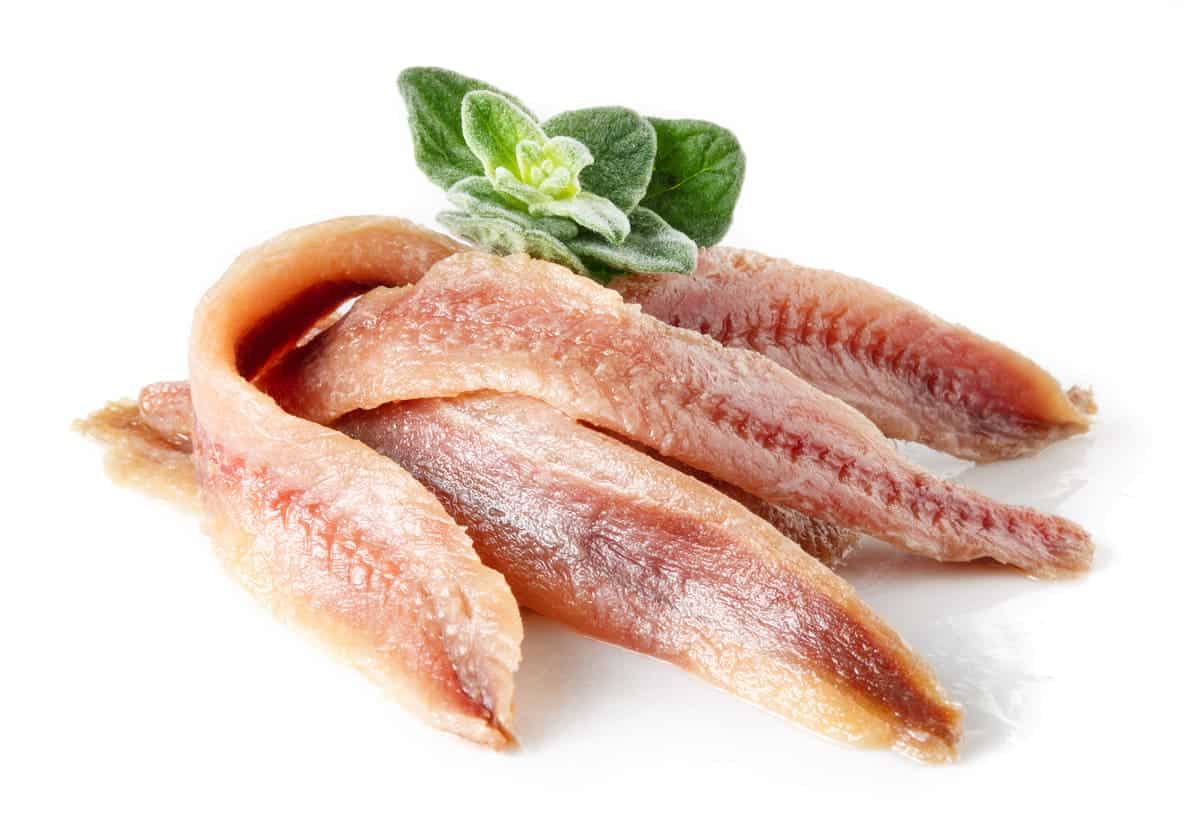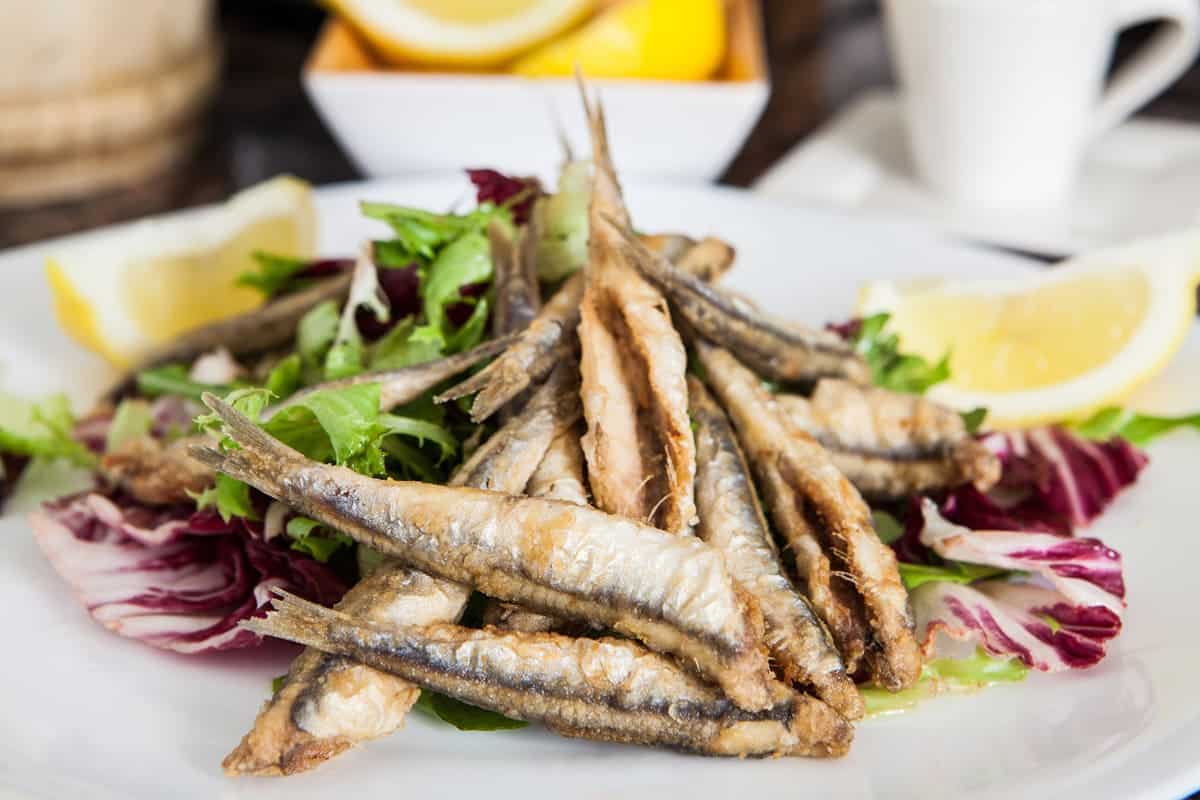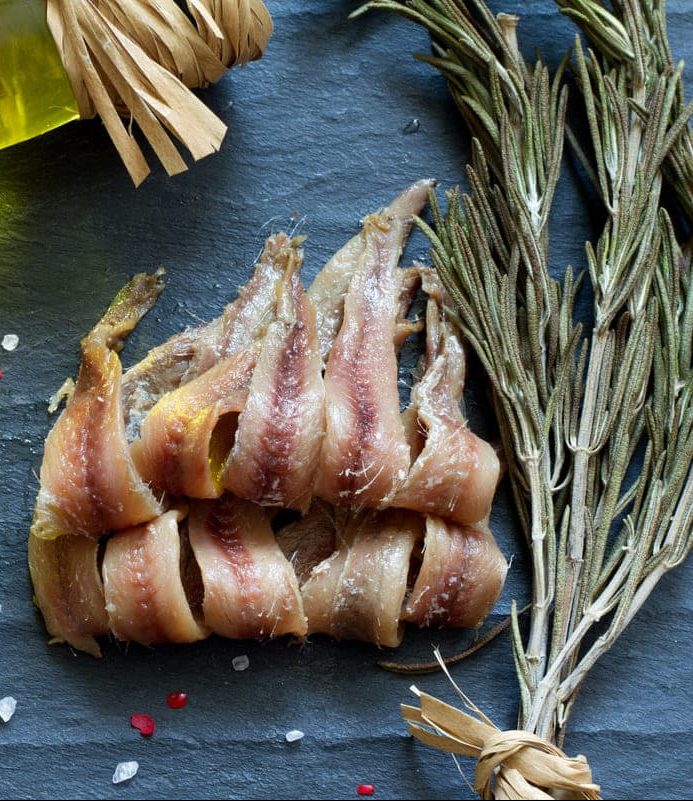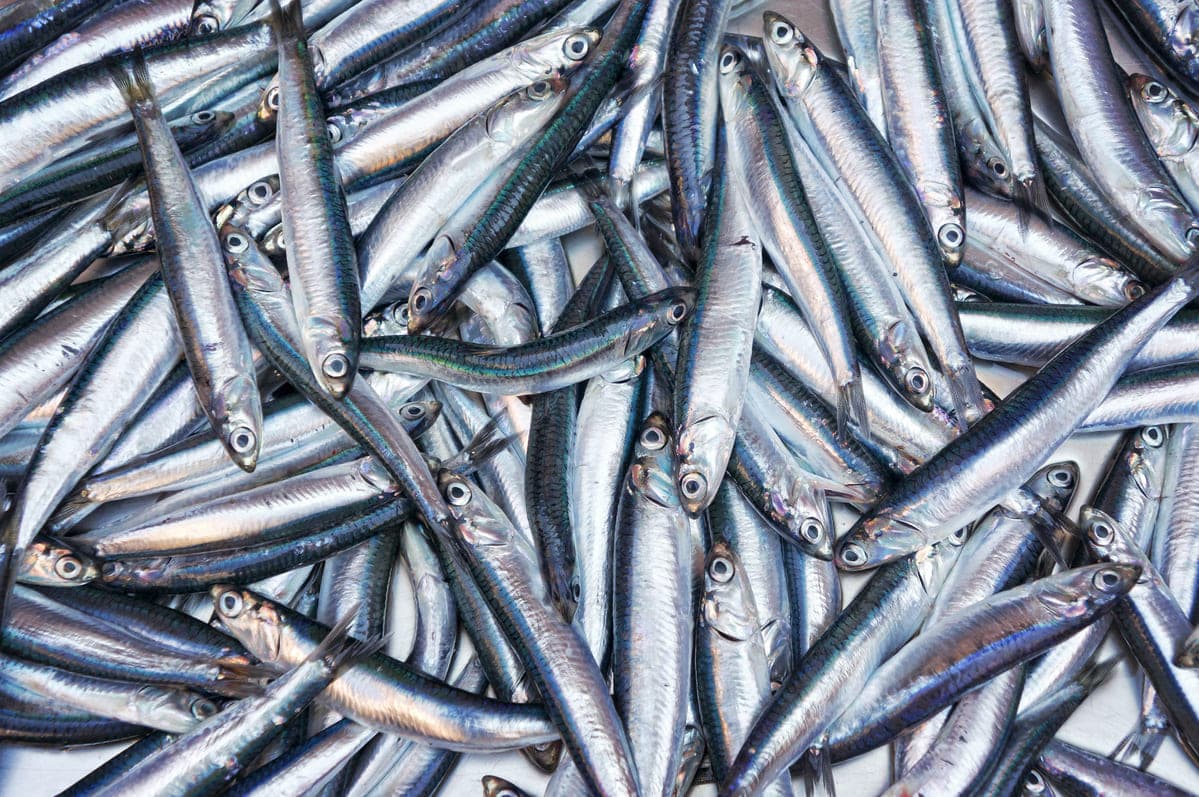
Introduction
Some people love anchovies, while others hate them. However, it cannot be denied that they are delicious. They can be used in a variety of ways other than being eaten straight up, as well.
Whatever you think of anchovies, there’s no denying their nutritional benefits. Let’s take a chance on these small fish now.
What are Anchovies?
Among the common saltwater forage fish, anchovies are relatively small fish in the family Engraulidae, which are used as food and bait for fish. A total of 144 species are found in the Black Sea, the Indian Ocean, the Pacific Ocean, and the Atlantic Ocean.
It is usually considered that fresh anchovies are oily fish. The caudal fin of this small fish has a silver line that gives it a blue reflective appearance.
It has a blunt snout and small, sharp teeth on each jaw. Snouts contain a unique organ that is believed to serve as an electro-sensor. Herrings and silversides, similar to anchovies in many ways, have smaller mouths than anchovies.
Their adult size ranges from 2 to 40 centimetres, and they have slimmer bodies in the north. Plankton and young fish are two of the anchovy’s primary food sources.
It is a small fish with a strong flavour, and it is oily. Most people eat them raw or barely cooked, though they can also be fermented or smoked.
Anchovies are also available in oil or salt packages or canned. Polyunsaturated fats in its oil, including omega-3 fatty acids, are beneficial in lowering cholesterol and preventing coronary disease.
Anchovies are celebrated as a culinary specialty in Italy. They are used as toppings for pizza, soups, salads and pasta in puttanesca sauce.
It is common to eat anchovies raw or cooked as whole fish. The salt content of pickled anchovies is lower than that of cured anchovies.

Fish processing: Anchovies
Anchovies are traditionally processed and preserved by gutting and salting them in brine, allowing them to develop, and then packing them in a salt or oil mixture. As a result, whole anchovies’ flesh turns dark grey and creates a distinctive flavour.
Besides remoulade, Worcestershire sauce, and various fish sauces, anchovies are also an ingredient in some butter. The extra layer of robust flavour of anchovies makes them an excellent addition to recipes.
Fresh Anchovy fillets
Water or ice is generally used to pack them. You can season them with various spices, including onion powder, garlic powder, dill, cayenne pepper, black pepper, paprika, chilli powder, oregano, thyme, basil, parsley, tarragon, rosemary, and sage. Smoking sardine fillets are sometimes done with fresh fish.
In most cases, fish fillets are packaged in brine or water. The fish will retain moisture during storage this way. To prevent drying out, sugar or salt may also be applied.
Canned Anchovies
Anchovies are usually cut into pieces rather than whole fillets, so they are smaller than those found in most supermarkets. Anchovies packed in olive oil are the best to buy when purchasing canned anchovies. Compared to vegetable oil-packaged items, these have a lower sodium content per serving.
Depending on how canned fish is processed and packaged, it will have different looks and flavours.
Pickled Anchovies
A brine is used to preserve the anchovies, which are then packaged in containers. A whole fish or fillet is usually available for sale. Compared with salt-cured or smoked anchovies, pickled anchovies are less salty.
In vinegar-pickled anchovies, the flesh remains white, and the flavour is milder.
Dried Anchovies fillets
Typically, dried anchovies are wrapped in plastic bags that have been vacuum sealed. A salad or sandwich often contains them. It will help to wash off excess salt before eating these salty anchovies.
Salted Anchovies
Saltwater is used to cure the anchovies, as their name suggests. Anchovies salted are usually eaten raw or cooked just a little bit. Restaurants that serve sushi are most likely to have them.
Anchovy paste
Anchovy paste and anchovy essence are also available. The UK also sells anchovy mash. Many dishes are flavoured with them in tiny amounts.
It is comparable to tomato paste in that salt-cured anchovies are ground fine and packaged in tubes. Cooking with anchovies just got a whole lot easier.
Fish sauce
Often, anchovies are a component of Asian fish sauce, used for savoury vegetable dishes and Asian dishes such as larb and pho.
What is the taste of anchovies?
Due to their affordability, ease of preparation, and saltiness, anchovies are called the poor man’s caviar. Besides their saltiness, anchovies also provide a unique taste.
It has an intensely fishy, salty taste, which can be too strong if not balanced correctly. The amino acid glutamate in anchovies gives them a savoury taste called umami.
Some places serve pizza with anchovies as a topping. Garum, a fermented fish sauce, was made with anchovies in ancient Rome. The shelf life of garum was sufficient for international trade, and it was possible to manufacture large quantities. Also, raw anchovies are believed to be an aphrodisiac.

Benefits of eating Anchovies
Most anchovies’ health benefits are attributed to their nutrients, not the fish itself. There are, however, many health benefits associated with these fish.
Keeping your heart healthy
Omega-3 fatty acids found in anchovies are powerful heart-health benefits. In studies, they have been shown to reduce blood pressure, slow plaque buildup in arteries, and lower triglyceride levels. Furthermore, they may reduce the risk of stroke by preventing blood clots.
Protein-rich food
Protein-rich foods help you lose weight because they help you feel satisfied when consumed as part of a healthy diet.
Compared to low-protein diets, high-protein diets promote a slower rate of weight gain and promote lean muscle mass preservation.
Keeping your eyes healthy
According to experts, men should consume 1.6 grams of omega-3 fatty acids daily, while women should consume 1.1 grams. Anchovies contain 0.45 grams of omega-3 per serving. Researchers suggest that omega-3-rich diets reduce the likelihood of macular degeneration, a condition that can result in blindness.
Protecting the thyroid
Selenium should be ingested by adults and teens in the amount of 55 mcg daily. It was discovered in the 1990s that selenium plays a vital role in activating thyroid function. It has also been suggested that a selenium deficiency may cause thyroid disorders.
Healthier brains
Brain cells require omega-3 fatty acids to form and function properly. Alzheimer’s disease, dementia, and depression have been linked to their deficiency.
Anticancer properties
Inhibiting the tumour’s growth and spreading may be possible with omega-3’s inflammation-reducing properties and selenium’s antioxidant qualities.
Nutritional profile of Anchovies
Niacin is a vitamin that helps turn food into energy, and anchovies are a rich source of it. Furthermore, they are loaded with selenium, a mineral that contributes to the health of the cardiovascular system, thyroid gland, immune system, and bones.
Iron and calcium are also found in them. Oxygen is transported from your lungs by iron in your body. Bone strength depends on calcium.
The omega-3 fatty acids found in anchovies are also beneficial. Like salmon, tuna, mackerel, and sardines, anchovies are oily or fatty.
Most anchovies’ health benefits are attributed to omega-3 fatty acids, selenium, and vitamin B3.
Anchovies risks and downsides
Due to their cured nature, anchovies tend to be highly sodium-rich. You can develop high blood pressure by consuming too much sodium. Sodium intake should be monitored closely by people with hypersensitivity to salt, obesity, diabetes, kidney disease, and hypertension.
Rinsing anchovies before eating them reduces their sodium content.
In addition, raw anchovies can cause anisakiasis, an infection caused by a parasite that lives in fish. Symptoms may include stomach cramps, vomiting, nausea, diarrhoea, high temperature, or a rash caused by an allergic reaction.
To avoid these symptoms, eat cooked anchovies, and consult your doctor if any of these symptoms occur.
What to look for in buying Anchovies
Clean and not muddy tastes are the sign of good anchovies. A creamy texture is not desirable. In addition, the oil in which they are stored shouldn’t have oxidized them. The inside should be pink, even if the outside is grey or silver. There’s nothing wrong with eating feather bones, but it’s not recommended that you munch on them. The fish must be flexible and soft.
Despite their freshness, they are unlikely to be blemish-free. Bruising is easy due to the softness of the flesh. Freshness can be judged by smell. The smell of anchovies, when they are spoiled, is unbearable. Make sure the eyes of the fish are bright, as with any fresh fish.
The paste has gained widespread popularity due to the limited anchovies required in most recipes. Because it is packaged in a tube, small quantities are easy to dispense. Water, vinegar, and spices are added to the anchovy paste.
Storing Anchovies
Even before opening, anchovies must be refrigerated to protect them from heat. There is a partial pasteurization involved. As a result of storing them near your stove, which varies in temperature, they may dissolve. These are fine to use in sauces and dressings, but they could be better for eating.
After opening, anchovies in jars should be stored in the fridge under a tightly closed lid. If you use tinned anchovies, remove them from the can and place them in a bowl. To prevent them from spoiling, submerge them in oil, or add salt to salt-packed anchovies if needed.
It is likely that the oil solidifies once refrigerated, but don’t worry; they will loosen up once they reach room temperature. You can store anchovies in the fridge for many months by topping them with salt or oil.
Anchovies can also be frozen, individually arranged on paper-lined trays, and opened frozen. After they have frozen, bag them and place them back in the freezer.
How to cook with Anchovies
Common method
These tiny fish arouse a strong dislike in many people. You might have had anchovies on your pizza and been disappointed. If someone opens a tin of anchovies, and the scent overwhelms you, that’s it. These experiences could be lifelong deterrents.
Anchovy-containing foods are popular; Caesar salad dressing and salad dressings come to mind. Being open-minded might be beneficial.
The skin of anchovies is delicious, and the scales are hardly noticeable. The scales and fins are intact and considered Halal and Kosher foods.
Preparing anchovy fillets involves gutting and bringing these fish, then sealing them with salt or oil. It is also possible to produce anchovy paste as a food ingredient. Spanish boquerones, pickled in vinegar, are milder than American boquerones.
Anchovies are the savoury “fifth taste” emphasized in the salt and condiment histories. Garum, the Roman salty fish sauce, is derived from them. Anchovies are used in many sauces today to enhance flavour, including remoulade, Worcestershire, and fish sauces.
The perfect food to pair with Anchovies
- Anchovies and unsalted butter on toasted bread.
- Garlic’s spice and the saltiness of anchovy create a delightful combination. Anchovy, tomato, a little garlic, oregano, and fresh oregano evoke the aroma and taste of pizza. Garlic, anchovies, and sweet peppers are also good combinations.
- Adding anchovies to mayonnaise will give it a unique flavour and delicious taste to T-bone steaks.
- Anchovies and white truffle melted into butter before dressing hot, boiled white potatoes. In addition, you can serve potatoes with a hot sauce made from cream and anchovies and with Beluga caviar.
- Combining anchovies with bitter-sweet vegetables such as cauliflower, cabbage, broccoli, young chicory shoots, and Brussels sprouts is best.
- Anchovy pairs well with provolone or mozzarella, as well as thyme and goat’s cheese.
- It is thought that anchovies are a great way to flavour meats with a pleasant sweetness, though not especially umami-rich. Anchovies and lamb are a great combination.
- Anchovies de-salted on toasted bread, goat cheese aged slightly, and honey. Essentially, sea flavour combines well with cheese, while creaminess mitigates and honey balances it out.
- The combination of anchovies, oranges, lemons, and grapefruit juice will surprise you with its freshness.
- Pineapple and anchovies. Nuoc nam sauce, made from finely chopped pineapple, garlic and chilli red pepper, is one of the most famous dips in Vietnamese cuisine. It is ideal for serving with fried fish or beef.
- Beetroot and anchovy. Because of beetroot’s sweetness, it helps balance anchovy’s salty taste.
- Coconut milk and anchovies. South East Asian cuisine offers one of the best pairings.
Anchovies and wine
Wine pairings with anchovies should balance out their saltiness. Hence, we should look for dry, mineral-rich wines with a strong almond flavour, an attribute of the best grape variety. With its finish, you can detect a greenish undertone.
White wine of complex aromas, a long finish, and a tangy note, capable of maturing and evolving; smooth and fresh on the palate, with a pleasant citrus flavour, it is perfect along with anchovies.

Popular Anchovies recipes to look out for
It is common to incorporate anchovies into recipes not because they are visually appealing or palatable but because they provide a distinct flavour. It is often anchovies that make a recipe come alive, the secret ingredient that makes it stand out.
Roasted lamb with anchovy cream on top
The roast leg of lamb is served in a creamy sauce seasoned with anchovies. Make a satisfying meal with a side of potatoes and vegetables.
A potato salad topped with anchovies and quail eggs
A great salad full of green beans, chives, fresh lemon juice, and parsley is perfect for lunch or a light dinner.
Niçoise-style pizza
This simple pizza is prepared with a ciabatta bread mixture accompanied by pesto, roasted green beans, melted cheese, olives, and anchovies.
Anchovy and courgette salad
With a hint of lemon and salty anchovies, this green side salad goes well with fish and meat meals.
Anchovy-crusted baked pollock
Garlic and rosemary breadcrumbs are the perfect toppings for white fish fillets.
Substitutes for Anchovies
Anchovies can be substituted for a variety of dishes. The best alternatives for anchovies are perfect for home cooks, whether you’re making a salad topping alternative, a garnish for pizza, or something else altogether.
Worcestershire sauce
Now let’s talk about the anchovies and Caesar salad. The original Caesar salad included Worcestershire sauce, the best substitution for anchovies. One of the reasons Worcestershire is such an excellent substitution is that anchovies are one of the primary ingredients.
Sauces, marinades, sauces, and casseroles can benefit from Worcestershire sauce. It can be used in Caesar dressing or for any other condiment or seasoning.
Because it is liquid, you can mix it into any recipe for a unique taste that will stand out.
Fish sauce
The fish sauce is also a convenient alternative to anchovies. You can add a little fish sauce to any dish to give it an intense umami flavour without adding Worcestershire sauce’s other components. To add an exciting taste, you can use fish sauce in pizza sauce, soups, stews, and dressings.
You should use only a tiny amount of fish sauce if you are using it, as too much may overwhelm the dish.
Miso
If you are looking for a vegetarian substitute for anchovies, miso is a good choice. Miso is made from soybeans and is a tasty paste. Like anchovies and anchovy pastes, miso provides a rich, umami flavour and is nutritional.
Sardines
You can substitute sardines for anchovies if you want a fish-based alternative. There are a lot of different flavours and textures in this one, so it’s a challenge.
There is a noticeable difference in the taste of anchovy and sardine. A sardine can be an excellent alternative to anchovies and crackers if you’d like a light snack.
If you prepare your dish correctly, you can substitute sardine fillets for anchovy fillets. In this instance, the anchovy flavour will be infused into the dish with a sauce like Worcestershire sauce.
Shrimp paste
For anchovy flavour on your pizza or for Asian dishes, you can substitute shrimp paste for the anchovies if you wish. The exact amount of shrimp paste would be used as you would with anchovy paste.
A lot of Asian cuisine uses these pastes. Using a grinder and salt to ferment the meat will give you shrimp paste or anchovy paste in a matter of minutes.
If you want something lighter, shrimp paste gives a unique flavour without the overpowering taste of anchovies.
Soy sauce
A popular alternative to anchovies is soy sauce when looking for a taste that’s a bit different. The best use for this sauce is as a dressing, sauce, soup, and in many other ways. Soy sauce can also be added to pasta sauces or pizza sauces.
Sustainability of Anchovies
As bottom feeders, anchovies have a fast growth rate and multiply rapidly.
Due to their resilience, anchovies can withstand high fishing pressure levels. Cornwall’s Anchovies likely originate in the south and move here during the warmer months of the year. Currently, there is a low fishing effort in Cornish waters due to the healthy anchovy stocks in the Bay of Biscay.

